UNCC300 - Justice and Change in the Global World: Education
VerifiedAdded on 2023/04/03
|7
|1213
|381
Essay
AI Summary
This essay addresses the critical issue of educational disparities in rural areas globally, focusing on the lack of shared responsibility for the common good. It begins by outlining the challenges faced by rural populations, including poverty, infrastructure deficits, and limited access to technology, which contribute to lower education levels compared to urban areas. The essay then proposes several strategies to improve rural education, such as enhancing infrastructure, integrating technology into teaching, and enlightening communities about the importance of education. It also emphasizes the role of government and non-governmental organizations in empowering rural communities through financial assistance and resource provision. The conclusion reinforces the significance of education in human development and advocates for a concerted effort to create conducive learning environments in rural areas to promote financial stability, reduce dependency ratios, and improve overall living standards.
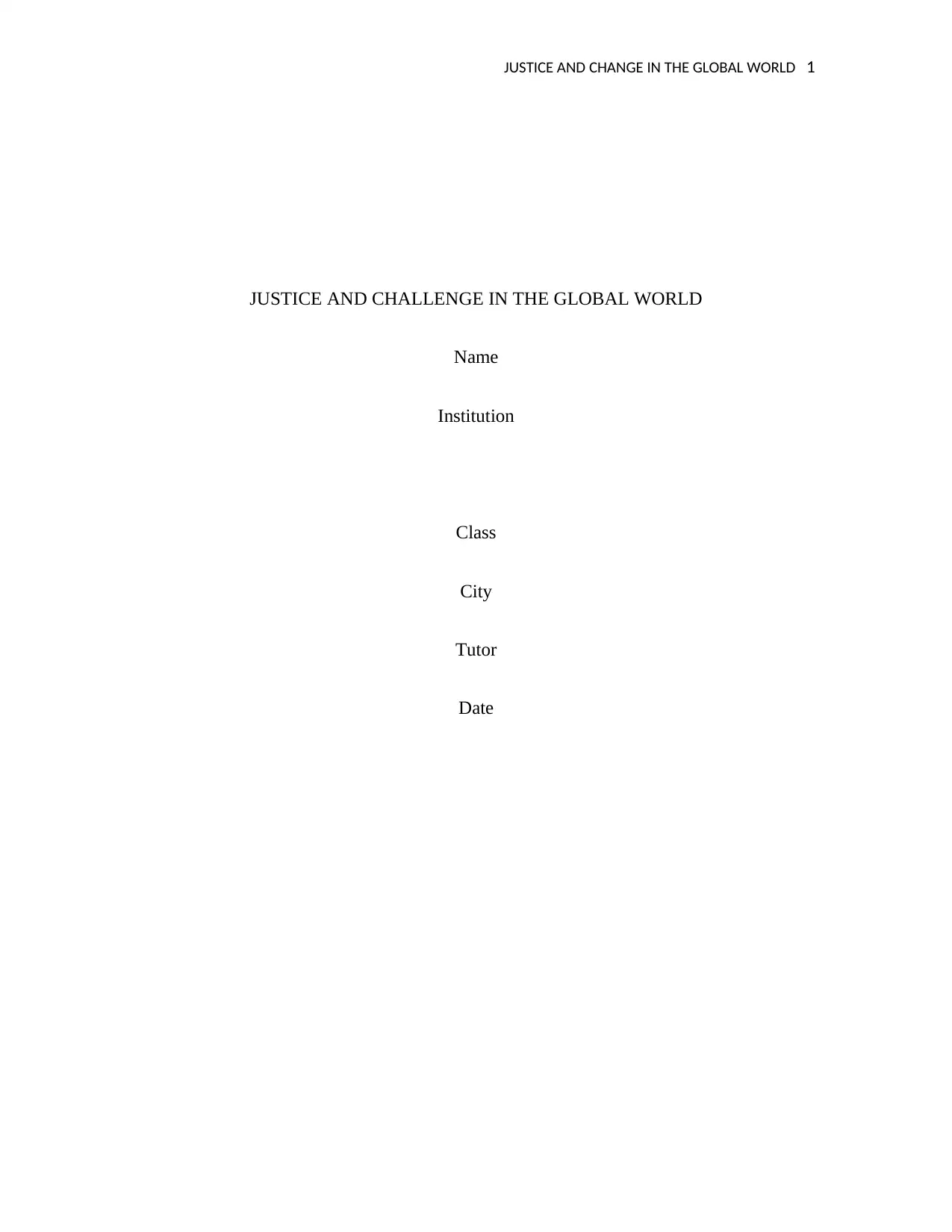
JUSTICE AND CHANGE IN THE GLOBAL WORLD 1
JUSTICE AND CHALLENGE IN THE GLOBAL WORLD
Name
Institution
Class
City
Tutor
Date
JUSTICE AND CHALLENGE IN THE GLOBAL WORLD
Name
Institution
Class
City
Tutor
Date
Paraphrase This Document
Need a fresh take? Get an instant paraphrase of this document with our AI Paraphraser
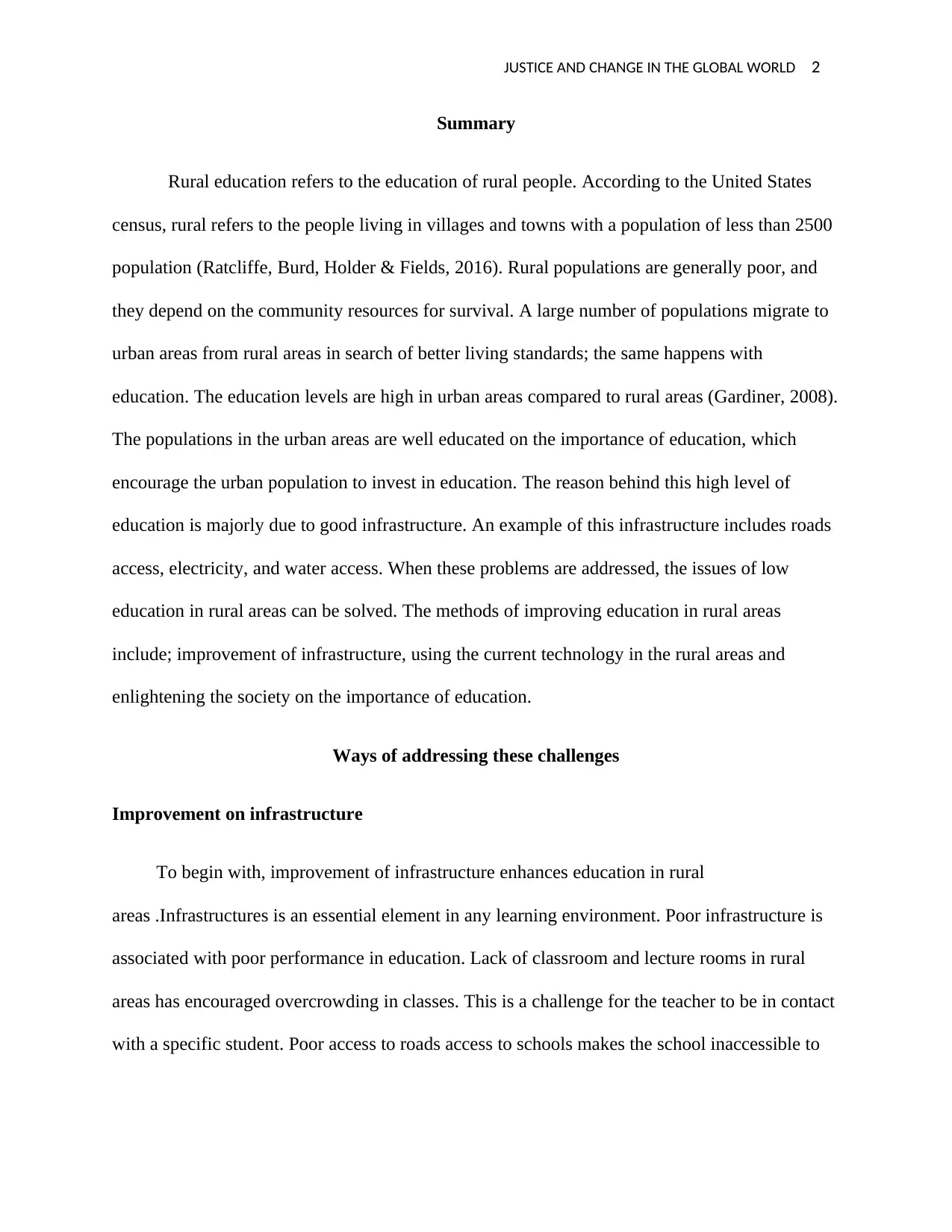
JUSTICE AND CHANGE IN THE GLOBAL WORLD 2
Summary
Rural education refers to the education of rural people. According to the United States
census, rural refers to the people living in villages and towns with a population of less than 2500
population (Ratcliffe, Burd, Holder & Fields, 2016). Rural populations are generally poor, and
they depend on the community resources for survival. A large number of populations migrate to
urban areas from rural areas in search of better living standards; the same happens with
education. The education levels are high in urban areas compared to rural areas (Gardiner, 2008).
The populations in the urban areas are well educated on the importance of education, which
encourage the urban population to invest in education. The reason behind this high level of
education is majorly due to good infrastructure. An example of this infrastructure includes roads
access, electricity, and water access. When these problems are addressed, the issues of low
education in rural areas can be solved. The methods of improving education in rural areas
include; improvement of infrastructure, using the current technology in the rural areas and
enlightening the society on the importance of education.
Ways of addressing these challenges
Improvement on infrastructure
To begin with, improvement of infrastructure enhances education in rural
areas .Infrastructures is an essential element in any learning environment. Poor infrastructure is
associated with poor performance in education. Lack of classroom and lecture rooms in rural
areas has encouraged overcrowding in classes. This is a challenge for the teacher to be in contact
with a specific student. Poor access to roads access to schools makes the school inaccessible to
Summary
Rural education refers to the education of rural people. According to the United States
census, rural refers to the people living in villages and towns with a population of less than 2500
population (Ratcliffe, Burd, Holder & Fields, 2016). Rural populations are generally poor, and
they depend on the community resources for survival. A large number of populations migrate to
urban areas from rural areas in search of better living standards; the same happens with
education. The education levels are high in urban areas compared to rural areas (Gardiner, 2008).
The populations in the urban areas are well educated on the importance of education, which
encourage the urban population to invest in education. The reason behind this high level of
education is majorly due to good infrastructure. An example of this infrastructure includes roads
access, electricity, and water access. When these problems are addressed, the issues of low
education in rural areas can be solved. The methods of improving education in rural areas
include; improvement of infrastructure, using the current technology in the rural areas and
enlightening the society on the importance of education.
Ways of addressing these challenges
Improvement on infrastructure
To begin with, improvement of infrastructure enhances education in rural
areas .Infrastructures is an essential element in any learning environment. Poor infrastructure is
associated with poor performance in education. Lack of classroom and lecture rooms in rural
areas has encouraged overcrowding in classes. This is a challenge for the teacher to be in contact
with a specific student. Poor access to roads access to schools makes the school inaccessible to
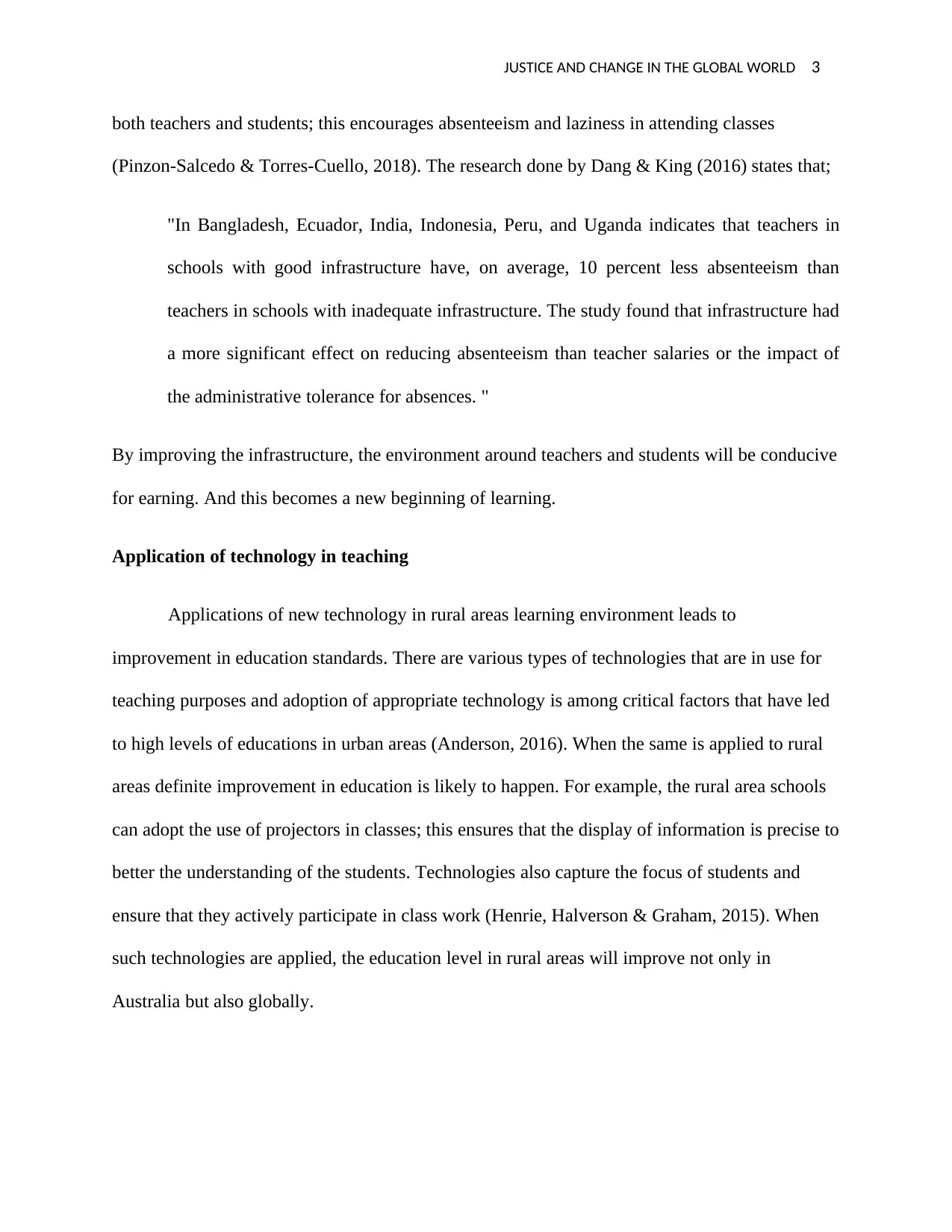
JUSTICE AND CHANGE IN THE GLOBAL WORLD 3
both teachers and students; this encourages absenteeism and laziness in attending classes
(Pinzon-Salcedo & Torres-Cuello, 2018). The research done by Dang & King (2016) states that;
"In Bangladesh, Ecuador, India, Indonesia, Peru, and Uganda indicates that teachers in
schools with good infrastructure have, on average, 10 percent less absenteeism than
teachers in schools with inadequate infrastructure. The study found that infrastructure had
a more significant effect on reducing absenteeism than teacher salaries or the impact of
the administrative tolerance for absences. "
By improving the infrastructure, the environment around teachers and students will be conducive
for earning. And this becomes a new beginning of learning.
Application of technology in teaching
Applications of new technology in rural areas learning environment leads to
improvement in education standards. There are various types of technologies that are in use for
teaching purposes and adoption of appropriate technology is among critical factors that have led
to high levels of educations in urban areas (Anderson, 2016). When the same is applied to rural
areas definite improvement in education is likely to happen. For example, the rural area schools
can adopt the use of projectors in classes; this ensures that the display of information is precise to
better the understanding of the students. Technologies also capture the focus of students and
ensure that they actively participate in class work (Henrie, Halverson & Graham, 2015). When
such technologies are applied, the education level in rural areas will improve not only in
Australia but also globally.
both teachers and students; this encourages absenteeism and laziness in attending classes
(Pinzon-Salcedo & Torres-Cuello, 2018). The research done by Dang & King (2016) states that;
"In Bangladesh, Ecuador, India, Indonesia, Peru, and Uganda indicates that teachers in
schools with good infrastructure have, on average, 10 percent less absenteeism than
teachers in schools with inadequate infrastructure. The study found that infrastructure had
a more significant effect on reducing absenteeism than teacher salaries or the impact of
the administrative tolerance for absences. "
By improving the infrastructure, the environment around teachers and students will be conducive
for earning. And this becomes a new beginning of learning.
Application of technology in teaching
Applications of new technology in rural areas learning environment leads to
improvement in education standards. There are various types of technologies that are in use for
teaching purposes and adoption of appropriate technology is among critical factors that have led
to high levels of educations in urban areas (Anderson, 2016). When the same is applied to rural
areas definite improvement in education is likely to happen. For example, the rural area schools
can adopt the use of projectors in classes; this ensures that the display of information is precise to
better the understanding of the students. Technologies also capture the focus of students and
ensure that they actively participate in class work (Henrie, Halverson & Graham, 2015). When
such technologies are applied, the education level in rural areas will improve not only in
Australia but also globally.
⊘ This is a preview!⊘
Do you want full access?
Subscribe today to unlock all pages.

Trusted by 1+ million students worldwide
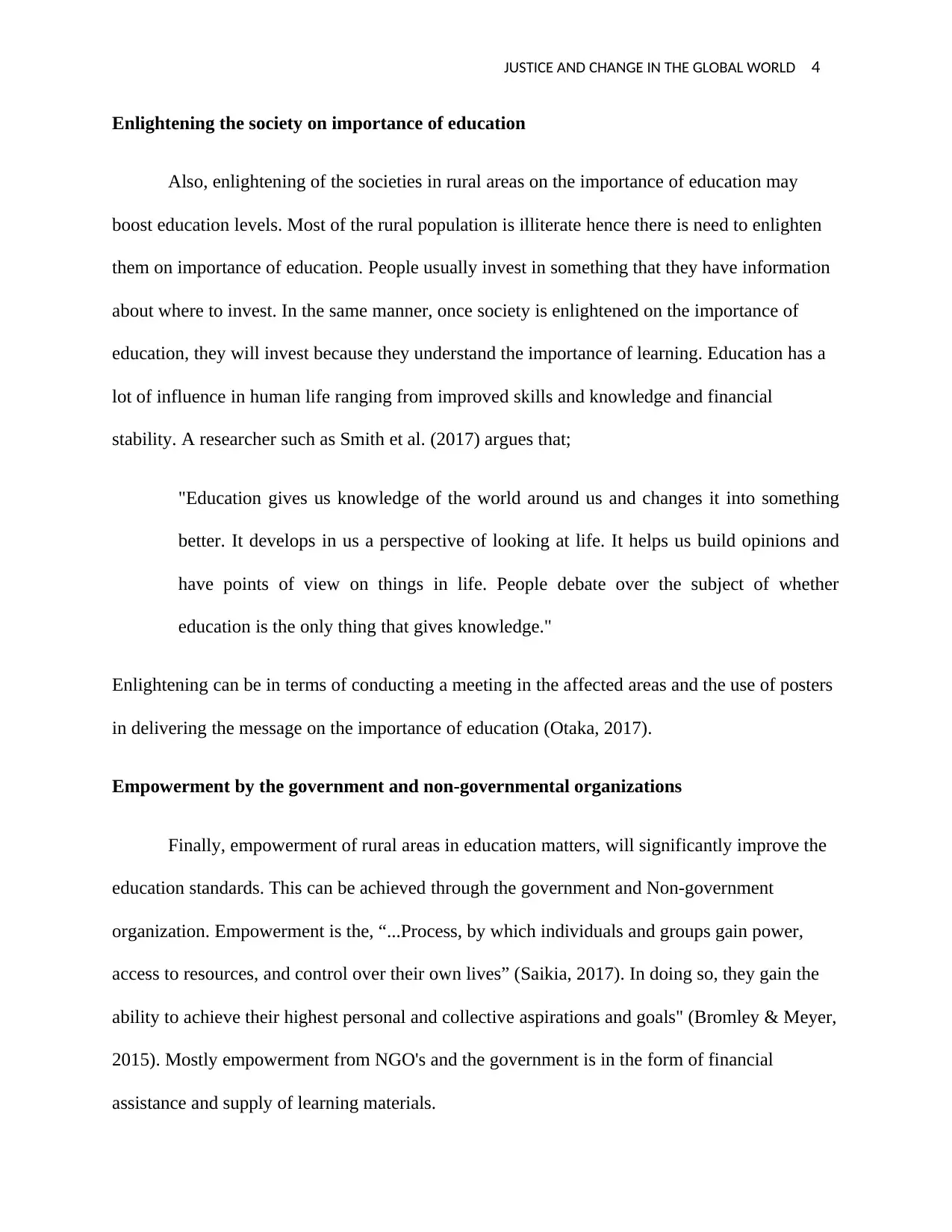
JUSTICE AND CHANGE IN THE GLOBAL WORLD 4
Enlightening the society on importance of education
Also, enlightening of the societies in rural areas on the importance of education may
boost education levels. Most of the rural population is illiterate hence there is need to enlighten
them on importance of education. People usually invest in something that they have information
about where to invest. In the same manner, once society is enlightened on the importance of
education, they will invest because they understand the importance of learning. Education has a
lot of influence in human life ranging from improved skills and knowledge and financial
stability. A researcher such as Smith et al. (2017) argues that;
"Education gives us knowledge of the world around us and changes it into something
better. It develops in us a perspective of looking at life. It helps us build opinions and
have points of view on things in life. People debate over the subject of whether
education is the only thing that gives knowledge."
Enlightening can be in terms of conducting a meeting in the affected areas and the use of posters
in delivering the message on the importance of education (Otaka, 2017).
Empowerment by the government and non-governmental organizations
Finally, empowerment of rural areas in education matters, will significantly improve the
education standards. This can be achieved through the government and Non-government
organization. Empowerment is the, “...Process, by which individuals and groups gain power,
access to resources, and control over their own lives” (Saikia, 2017). In doing so, they gain the
ability to achieve their highest personal and collective aspirations and goals" (Bromley & Meyer,
2015). Mostly empowerment from NGO's and the government is in the form of financial
assistance and supply of learning materials.
Enlightening the society on importance of education
Also, enlightening of the societies in rural areas on the importance of education may
boost education levels. Most of the rural population is illiterate hence there is need to enlighten
them on importance of education. People usually invest in something that they have information
about where to invest. In the same manner, once society is enlightened on the importance of
education, they will invest because they understand the importance of learning. Education has a
lot of influence in human life ranging from improved skills and knowledge and financial
stability. A researcher such as Smith et al. (2017) argues that;
"Education gives us knowledge of the world around us and changes it into something
better. It develops in us a perspective of looking at life. It helps us build opinions and
have points of view on things in life. People debate over the subject of whether
education is the only thing that gives knowledge."
Enlightening can be in terms of conducting a meeting in the affected areas and the use of posters
in delivering the message on the importance of education (Otaka, 2017).
Empowerment by the government and non-governmental organizations
Finally, empowerment of rural areas in education matters, will significantly improve the
education standards. This can be achieved through the government and Non-government
organization. Empowerment is the, “...Process, by which individuals and groups gain power,
access to resources, and control over their own lives” (Saikia, 2017). In doing so, they gain the
ability to achieve their highest personal and collective aspirations and goals" (Bromley & Meyer,
2015). Mostly empowerment from NGO's and the government is in the form of financial
assistance and supply of learning materials.
Paraphrase This Document
Need a fresh take? Get an instant paraphrase of this document with our AI Paraphraser
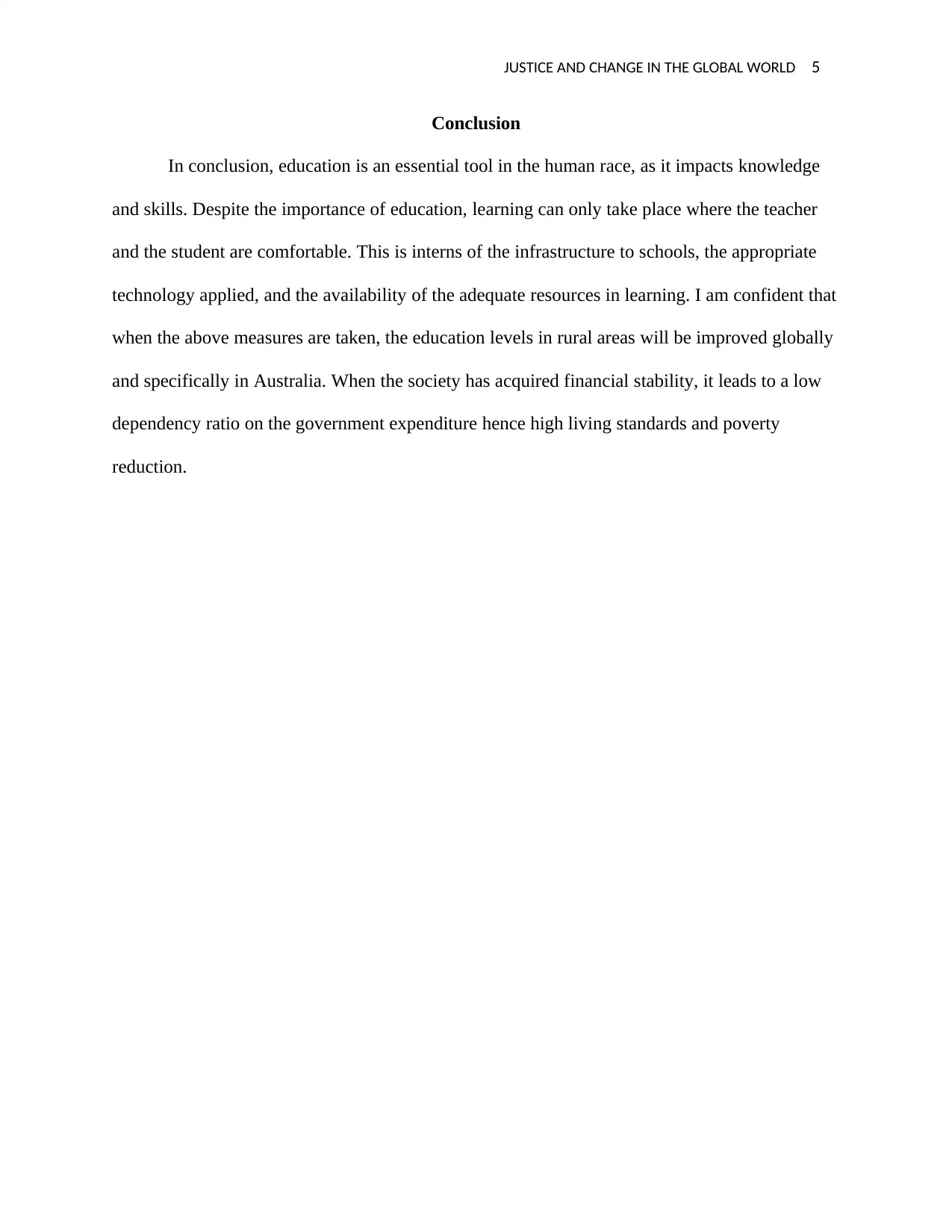
JUSTICE AND CHANGE IN THE GLOBAL WORLD 5
Conclusion
In conclusion, education is an essential tool in the human race, as it impacts knowledge
and skills. Despite the importance of education, learning can only take place where the teacher
and the student are comfortable. This is interns of the infrastructure to schools, the appropriate
technology applied, and the availability of the adequate resources in learning. I am confident that
when the above measures are taken, the education levels in rural areas will be improved globally
and specifically in Australia. When the society has acquired financial stability, it leads to a low
dependency ratio on the government expenditure hence high living standards and poverty
reduction.
Conclusion
In conclusion, education is an essential tool in the human race, as it impacts knowledge
and skills. Despite the importance of education, learning can only take place where the teacher
and the student are comfortable. This is interns of the infrastructure to schools, the appropriate
technology applied, and the availability of the adequate resources in learning. I am confident that
when the above measures are taken, the education levels in rural areas will be improved globally
and specifically in Australia. When the society has acquired financial stability, it leads to a low
dependency ratio on the government expenditure hence high living standards and poverty
reduction.
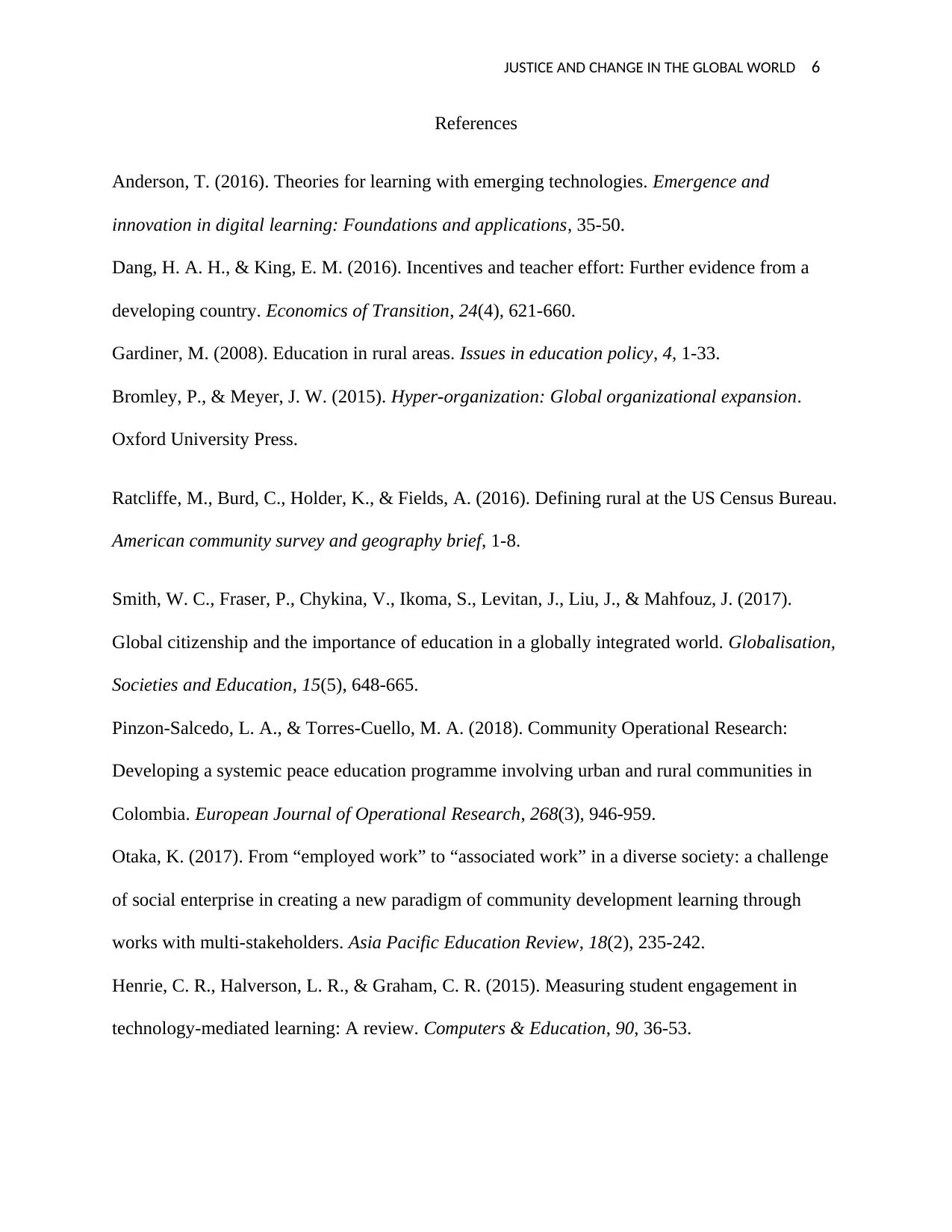
JUSTICE AND CHANGE IN THE GLOBAL WORLD 6
References
Anderson, T. (2016). Theories for learning with emerging technologies. Emergence and
innovation in digital learning: Foundations and applications, 35-50.
Dang, H. A. H., & King, E. M. (2016). Incentives and teacher effort: Further evidence from a
developing country. Economics of Transition, 24(4), 621-660.
Gardiner, M. (2008). Education in rural areas. Issues in education policy, 4, 1-33.
Bromley, P., & Meyer, J. W. (2015). Hyper-organization: Global organizational expansion.
Oxford University Press.
Ratcliffe, M., Burd, C., Holder, K., & Fields, A. (2016). Defining rural at the US Census Bureau.
American community survey and geography brief, 1-8.
Smith, W. C., Fraser, P., Chykina, V., Ikoma, S., Levitan, J., Liu, J., & Mahfouz, J. (2017).
Global citizenship and the importance of education in a globally integrated world. Globalisation,
Societies and Education, 15(5), 648-665.
Pinzon-Salcedo, L. A., & Torres-Cuello, M. A. (2018). Community Operational Research:
Developing a systemic peace education programme involving urban and rural communities in
Colombia. European Journal of Operational Research, 268(3), 946-959.
Otaka, K. (2017). From “employed work” to “associated work” in a diverse society: a challenge
of social enterprise in creating a new paradigm of community development learning through
works with multi-stakeholders. Asia Pacific Education Review, 18(2), 235-242.
Henrie, C. R., Halverson, L. R., & Graham, C. R. (2015). Measuring student engagement in
technology-mediated learning: A review. Computers & Education, 90, 36-53.
References
Anderson, T. (2016). Theories for learning with emerging technologies. Emergence and
innovation in digital learning: Foundations and applications, 35-50.
Dang, H. A. H., & King, E. M. (2016). Incentives and teacher effort: Further evidence from a
developing country. Economics of Transition, 24(4), 621-660.
Gardiner, M. (2008). Education in rural areas. Issues in education policy, 4, 1-33.
Bromley, P., & Meyer, J. W. (2015). Hyper-organization: Global organizational expansion.
Oxford University Press.
Ratcliffe, M., Burd, C., Holder, K., & Fields, A. (2016). Defining rural at the US Census Bureau.
American community survey and geography brief, 1-8.
Smith, W. C., Fraser, P., Chykina, V., Ikoma, S., Levitan, J., Liu, J., & Mahfouz, J. (2017).
Global citizenship and the importance of education in a globally integrated world. Globalisation,
Societies and Education, 15(5), 648-665.
Pinzon-Salcedo, L. A., & Torres-Cuello, M. A. (2018). Community Operational Research:
Developing a systemic peace education programme involving urban and rural communities in
Colombia. European Journal of Operational Research, 268(3), 946-959.
Otaka, K. (2017). From “employed work” to “associated work” in a diverse society: a challenge
of social enterprise in creating a new paradigm of community development learning through
works with multi-stakeholders. Asia Pacific Education Review, 18(2), 235-242.
Henrie, C. R., Halverson, L. R., & Graham, C. R. (2015). Measuring student engagement in
technology-mediated learning: A review. Computers & Education, 90, 36-53.
⊘ This is a preview!⊘
Do you want full access?
Subscribe today to unlock all pages.

Trusted by 1+ million students worldwide

JUSTICE AND CHANGE IN THE GLOBAL WORLD 7
Saikia, P. (2017). A study on the self-help group of women and its contribution to their socio-
economic development (Doctoral dissertation, Assam Don Bosco University).
Saikia, P. (2017). A study on the self-help group of women and its contribution to their socio-
economic development (Doctoral dissertation, Assam Don Bosco University).
1 out of 7
Related Documents
Your All-in-One AI-Powered Toolkit for Academic Success.
+13062052269
info@desklib.com
Available 24*7 on WhatsApp / Email
![[object Object]](/_next/static/media/star-bottom.7253800d.svg)
Unlock your academic potential
Copyright © 2020–2025 A2Z Services. All Rights Reserved. Developed and managed by ZUCOL.





